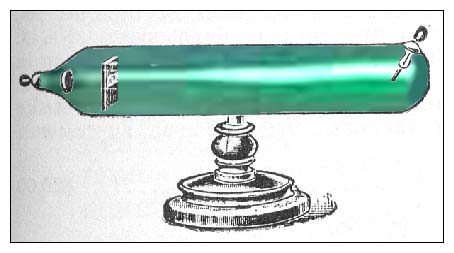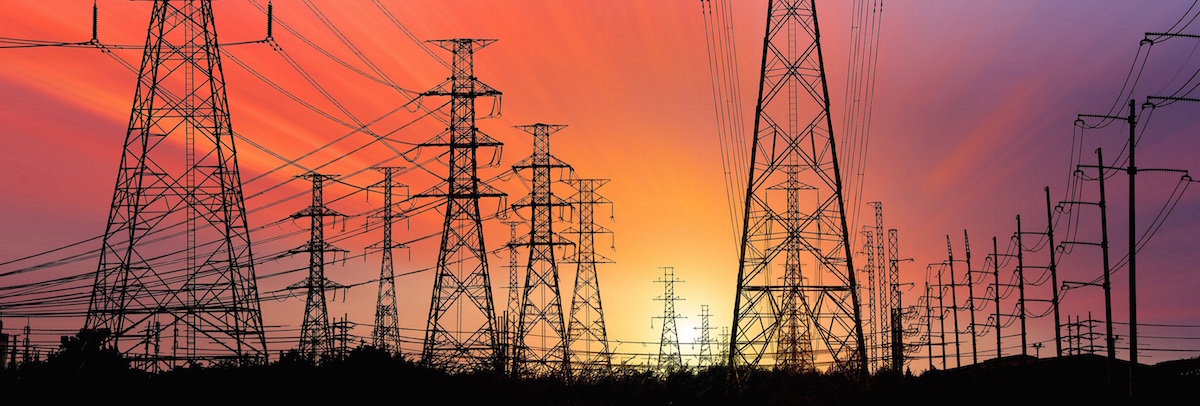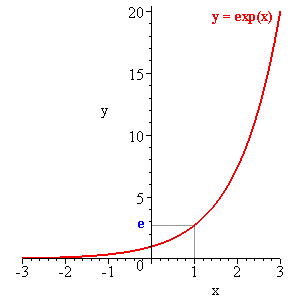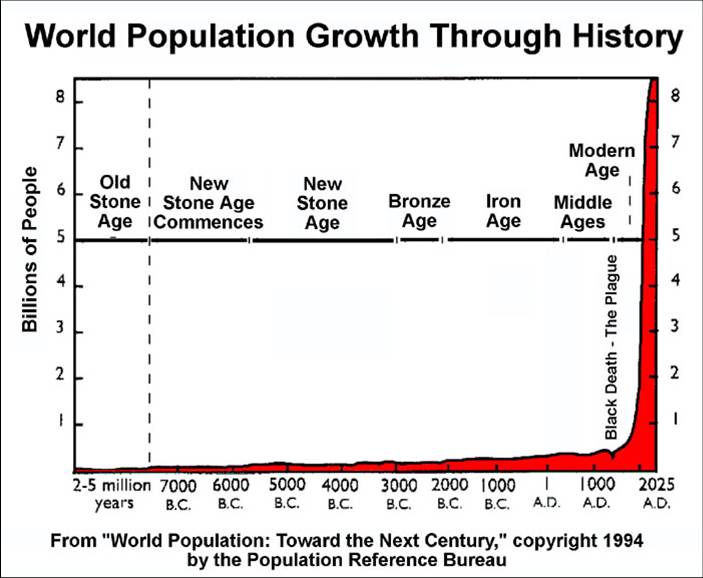ASTR 1210 (O'Connell) Study Guide
9. SCIENCE, TECHNOLOGY, & SOCIETY
| For an essay version of this webpage, click here |

US hydrogen bomb test, 11 megatons, 1954.
The image above is probably what leaps to mind when the subject of "science and society" is raised. This is a famous snapshot of the fireball from theA. Distinctions
It will help to be clear about the terminology:- Science: By my definition, science is the attempt to understand the universe, to build a conceptual framework. This is often called "fundamental," "pure," "unapplied," or "basic" research. Most research in astronomy falls in this category. Important examples of scientific accomplishment are Newton's theory of gravity, Maxwell's discovery of electromagnetic waves, Leeuwenhoek's discovery of microorganisms, and NASA's planetary exploration missions.
- Technology: Technology is the application of
basic concepts to solve practical problems (e.g. shelter, food,
transport, energy, medicine, tools, weapons). Technology may use our
basic scientific understanding but doesn't necessarily in itself
contribute to it. The word "invention" is often applied to
innovations in technology but not normally to scientific
discoveries. Engineering is applied science/technology.
Examples: structural and civil engineering, aeronautics, pharmacology,
and the Internet.
-
Technology always has a societal motivation, whether for
ultimate good or ill, but the main motivation for "basic" science is
simply curiosity and the desire to understand.
- Job descriptions:
-
Scientist: "Be curious"
Technologist: "Be useful"
B. Conversion of Basic Science to Technology
- Science now usually precedes technology
- This was obviously not true for the early technologies (e.g.
fire, stone tools, cloth, ceramics, metalworking, glass), which were
developed through trial and error, building on intuition drawn from
everyday personal and societal experience. Trial and error certainly
still figures in technology development, but the essential
foundations for experimentation since about 1800 have come from
science.
- Critical Conceptual Path: For each
important new technology, we can construct a "critical conceptual
path" of the main steps leading to its realization. Almost all
modern technologies depend on a long list of discoveries in basic
science. Most will go all the way back
to Newton and Kepler.
-
Individuals like Galileo, Einstein or Pasteur have made important breakthroughs,
but progress in science inevitably depends on the contributions of
many people. For instance, a
recent study of the development of a new drug to fight metastatic
melanoma concluded that its critical conceptual path extended back
over 100 years and involved 7000 scientists working at 5700 different
institutions. Most of this path involved basic research disconnected
from immediate commercial or clinical applications.
The recent development of vaccines for the COVID-19 virus is a perfect
example of how basic research underpins essential technology. With
older technology, it normally took years to perfect viral vaccines.
However, the discovery of the structure and function of
the "messenger
RNA" molecule in 1961 began a chain of research that ultimately
led to the very rapid development, in only a few months' time, of
COVID-19 vaccines that use mRNA to induce human immune system
resistance to the virus.
- Key contributions of science to technology:
- Methods: critical thinking, skepticism, rational analysis,
empirical testing, calculus, statistics, double-blind medical trials,
etc.
Knowledge: Newton's Laws of Motion (mechanics), thermodynamics,
electromagnetism, chemistry, biology, hydrodynamics, structure of matter, etc.
- The enabling discoveries in the critical conceptual path are
often motivated by curiosity rather than potential applications.
- This is why politicians and opinion-makers who insist on the
"relevance" of scientific research, especially in terms of near-term
applications, are misguided --- and may even inhibit progress.
"There is no 'useless' research."
---- Nathan Myhrvold, Chief Technology Officer, Microsoft Corporation "There are two possible outcomes [of an experiment]: If the result confirms the hypothesis, then you’ve made a discovery. If the result is contrary to the hypothesis, then you’ve made a discovery."
---- Enrico Fermi, nuclear physicist
Experimental cathode-ray tube (ca. 1875): forerunner of X-ray and TV tubes.
- The time scale for conversion of basic discoveries to useful
technologies varies enormously
- Examples
- X-Rays (1895): X-Rays
were accidentally discovered by Roentgen in the course of basic
research on the physics of electromagnetic waves using cathode
ray tubes like the one above. Click here for a sample 1896 X-ray. Conversion time to medical
imaging applications: 1 year.
-
This is a good example of a technological problem that couldn't be solved by
trying to solve it. A direct engineering approach to devising a
non-invasive mechanism to examine internal human anatomy would have
failed utterly.
- Human Space Flight (1961): The basic scientific concepts needed to build rockets and navigate them through space had been known since the 19th century, so the investment of large amounts of $$$ (in both the US and USSR) solved the remaining technical problems within 5 years of a political decision to go forward. Conversion time: 280 years (from Newtonian orbit theory, the essential conceptual foundation of space flight).
- CD/DVD Players (1982): Here, the critical conceptual path includes Einstein's work on induced transitions of electrons in atoms (1916), which was the essential idea in creating the lasers that are used to convert digital recordings into electronic signals. (Similar lasers are the basis of data transmission by fiber-optic cables, now the main technology used to drive the Internet.) Conversion time: 66 years.
- X-Rays (1895): X-Rays
were accidentally discovered by Roentgen in the course of basic
research on the physics of electromagnetic waves using cathode
ray tubes like the one above. Click here for a sample 1896 X-ray. Conversion time to medical
imaging applications: 1 year.
- Examples
- Technology is a fundamental test of the validity of scientific ideas
-
Modern technology is applied science. As pointed out
in Study Guide 1, if our science was not
right, then most of our technology would simply not work. Even though
it's not readily visible to us, our everyday experience in modern
societies depends on the quality of our scientific understanding of
nature on scales from the atomic to the cosmic.
-
By the way, this is also the best answer to the notion of "social
constructivism" -- popular with some philosophers and social
scientists -- that prevailing scientific theories are more a product
of social conventions, political currents, or a power hierarchy than
objective data from the real world. Scientists emphatically reject
this argument. They accept that they are subject to all the same
social pressures, foibles, and character flaws as other people. They
make mistakes, exercise bad judgement, and can have strongly
subjective biases (mostly in favor of their own ideas). However, the
difference in terms of the results of science is that the demand for
empirical verification provides an external standard for
determining which ideas have merit, and this ultimately produces
robust interpretations of nature, which can be used to benefit all
mankind. If the lights come on, the airplane flies, the antibiotic
cures, then the "socially constructed" argument goes down the drain.
C. The "Big Four" Benefits of Science/Technology to Society
INFORMATION TECHNOLOGY
-
None of the refined, modern versions of human technology would exist
without the ability to record vast amounts of information and transmit
it from person to person and generation to generation. Through
medieval times it was possible to convey knowledge on a modest scale
by laborious manual writing and copying and some scattered
experiments with printed material. However, only the advent of
mass-produced printed books based
on Gutenberg's
design of printing presses using metallic movable type (ca. 1440)
opened the doors to the information revolution. Within 150 years, an
amazing 200 million volumes had been printed.
Books ushered in the modern age. Science depended on them.
Universities flourished because the ability to deal with large amounts
of specialized information in books became essential to society.
Beginning in the mid 19th century, information transfer proliferated
thanks to the automated rotary press and inventions like the telephone
and the linotype machine. In the last 30 years, the Internet and
other electronic technologies have accelerated the spread and creation
of information. Their societal impact has not yet matched the
monumental watershed established by the printed book, but the related
looming prospect of
artificial general intelligence would do so.
AGRICULTURAL GENETICS
-
"Genetic engineering," the creation of artificial life forms, is
nothing new. It has been going on for thousands of years (long before
we even recognized the existence of genes). You will be shocked when
you click on this picture of the
most familiar artificial life form. Almost all the food we eat
is derived from deliberate human manipulation of plant and animal gene
pools. (The main exception is wild seafood.) Until the mid 20th
century, the techniques employed were cross-fertilization, selective
breeding, population culling, and other "natural" methods. As our
understanding of genetics matured (ca. 1900-1950), these techniques
became science-based. Eventually, it became possible to directly
manipulate cellular material (ca. 1970+). Molecular biology now
offers an ultimate genetic control technology.
CONTROL OF INFECTIOUS DISEASE
-
The control of the microorganisms (bacteria, viruses, fungi,
parasites) that cause infectious disease is one of the most important
contributions of science & technology. In fact, many of us would not
be alive today without it because a direct ancestor would have died
too early. The COVID-19 pandemic serves as a grim reminder of the
almost-forgotten dire threat of infectious diseases like bubonic
plague, smallpox, tuberculosis, malaria, cholera, polio, and AIDS.
These often swept through human populations, killing huge numbers of
individuals. But as recently as 350 years ago, communicable disease
was thought to be produced by evil spirits, unwholesome vapors,
"miasmas," or other mysterious agents. No one imagined that it was
caused by invisible lifeforms until
Leeuwenhoek
in 1676 used the newly-invented
microscope to discover microscopic organisms. Widespread
production of agents --
"antibiotics"
and
"vaccines" -- that
could attack specific types of harmful bacteria and viruses or prevent
infection in the first place was one of the most important advances in
medical history.
"Public health" consists mainly of systematic methods for
controlling microorganisms.
ELECTRICITY
- Electricity is the primary tool of modern civilization, yet
few people appreciate this or have any idea of how electricity
was discovered or converted to useful technologies. We
explore the development and contributions of electricity in
the next section.

D. Electricity: A Case Study
Electricity is ubiquitous today in all but the most primitive societies. The most obvious manifestation of electricity is in sophisticated electronics: smart phones, DVD players, personal computers, HD TV, video games, and so forth. But these are luxuries, and it should be easy to imagine being able to live comfortably without them---in fact, people did so only 35 years ago. We don't really need fancy consumer electronics, but we do need electricity. Our reliance on electricity is profound, and its use is so deeply embedded in the fabric of civilization that we mostly take it for granted. At least until there's a power failure.-
Electricity supplies almost all of the power we depend on and
is essential for manufacturing, agriculture, communications,
transportation, medicine, household appliances, and almost every other
aspect of modern life. It's easy to overlook the ubiquity of
electricity by thinking only in terms of obviously "electrical"
devices:
-
One crucial example: all the internal combustion
engines used in cars, trucks, locomotives, ships, and planes require
electrical ignition systems.
Two others: refrigeration and water distribution and
purification systems. Imagine the challenges in providing food and
medication to the world's population today in the absence of
electrically powered refrigerators. Anyone who appreciates hot
showers taken indoors is an unknowing admirer of electric pumps.
-
The most powerful control systems in use today are, of
course, computers and microprocessors. These outperform human
brains in raw processing speed by factors of many millions and have
advanced to the point of duplicating or superseding human performance
in games like chess or in operating an automobile. They are used on a
scale that would have been inconceivable to people only 75 years ago.
Nonetheless, that generation also depended on electricity for control
systems: think of the
telephone
operator plug-boards of the "one ringy-dingy" era.
-
More seriously, if we somehow became unable to use electricity, our
economy would collapse overnight, taking our Gross Domestic Product
back to the level of about 1900. More than half of the population
would probably die off within 12 months, mostly from starvation and
disease.
The 2012-14 NBC-TV
series "Revolution"
showed an action-oriented version of what a fictional post-electricity
world might be like (though one where everybody still manages to have
good hair).
An all-too-real threat to our electrical infrastructure
is posed by magnetic activity on the Sun, particularly "coronal
mass ejections." In July 2012
the Earth
only narrowly missed a CME from a solar superstorm that could have
devastated our electrical grid.
Development of Electric Technology
Electricity is the everyday manifestation of electromagnetic force, the second kind of inter-particle force (after gravity) that scientists were able to quantify. Here is a very brief history of our understanding of EM force, divided between "basic" and "applied" developments:- ca. 1750-1830: Coulomb, Orsted, Ampere, Volta, (Benjamin) Franklin, and other physicists explore the basic properties of electric and magnetic phenomena. Orsted and Ampere show that an electric current moving in a wire could produce a magnetic field surrounding it. Basic.
- Faraday (1831)
(experimental physicist): discovers electromagnetic induction.
Basic.
- Faraday discovers that a changing magnetic field could
induce an electric current. Together with the fact that an
electric current could induce a magnetic field, this demonstrates the
symmetry of electromagnetic phenomena.
This is also the key to the development
of electric generators
and motors, which convert
mechanical force to electrical force, and vice-versa, using magnetic
fields. These are two of the essential technologies of the electric
age.
Since 1850 most large-scale electrical generators rely on
steam
engines to help convert mechanical energy into electrical
energy. (Various types of wood- or coal-burning steam engines had
been developed in Great Britain in the period 1760-1800 and were
so effective at increasing economic productivity in commercial
mining and textile manufacturing that they became the basis of the
Industrial Revolution.) Today,
steam turbine engines are most commonly used in large
electric generators.
Applied.
- Edison (technologist) and others (1830--1900) develop practical
electrical generators, motors, distribution grids, and appliances.
Applied.
-
Many people think Edison "invented" electricity. He didn't.
He invented a large number of electrical appliances---including
the electric light, tickertape machines, the motion picture camera &
projector, etc. But these all depended on a pre-existing supply of
electricity and the knowledge of how to use it---all
contributed by basic research in physics.
- Readily available electricity stimulates the invention of the telegraph (1830's) and telephone (1870's), fundamentally changing human communications (and, needless to say, behavior). Applied.
- Maxwell (physicist): in 1865, Maxwell deduces equations giving a
complete description of the observed electrical and magnetic (EM)
phenomena. From these, he predicts the existence
of electromagnetic
waves traveling at the speed of light and thereby
demonstrates that light is an electromagnetic phenomenon, one
of the most important discoveries in the history of science.
Basic.
- The fact that these EM waves can have arbitrary wavelengths
implies the existence of a broad
electromagnetic spectrum, which includes the
regions we now use for radio and television. No one had
even suspected the existence of this vast spectrum, which is
mostly invisible to our eyes.
- Hertz (physicist, technologist): accomplishes the first generation & detection of artificial radio waves (1887). After he demonstrated the existence of radio waves, Hertz admitted that he could not see any practical applications for them. Eight years later, as described above, Roentgen discovers the X-ray region of the EM spectrum, the practical applications of which, by contrast, were immediately apparent. Both Basic and Applied.
- Tesla, Marconi and many others develop methods for routine transmission and reception of EM radio waves. Just as important are new inventions -- such as vacuum tubes (1907) -- for modulation of EM waves so that an intelligible signal could be impressed on them. This leads to commercial radio (1920) and television (1936). All of our "wireless" technology today is similarly based on radio waves. Applied.
- The development of quantum mechanics
(Basic) after 1925 leads to the
miniaturization of electrical circuits using solid-state materials
like silicon and the invention (Applied) of the
transistor
(1947) and
integrated
circuit (1959), which are the central components of all the
electronics in use today.
- The quantum-based technologies are probably responsible for at
least 50% of our Gross Domestic Product today -- so one of the
largest contributors to our economic well being was developing an
understanding of how electrons move in chunks of silicon. Who
could have predicted that?

E. A Brave New World
The cumulative effect of science-based technologies, including the myriad applications of electricity and electromagnetic waves, has been profound. Living conditions for most human beings have been radically transformed for the better since 1500 AD. By every measure -- freedom, equality, wealth, health, safety, comfort, opportunity, meaningful work, and so on -- the present circumstances for the great majority of all people are an unprecedented improvement over the past. They are an improvement even over the lifestyles of the most privileged individuals in earlier history --- there aren't many sensible people today who would trade indoor plumbing for rubies and emeralds.-
These six
charts show the dramatic improvement over the last 200 years
in important indicators like poverty, child mortality, and literacy.
The long-term historical decline in violence among human
societies is illustrated in this slide presentation.
-
In this vein, also think about this: When you get some kind of injury
or malady and you go to a doctor, you automatically assume you will be
effectively treated and usually cured. That's a new assumption. It
wasn't true throughout all of human history until about 100 years ago.
In fact, one historian of medicine noted that before about 1850, "most
people were fortunate in being unable to afford treatment" ---
because medical care then was often
counterproductive, brutal, and dangerous.
- Up to the late 18th century, implementation of new technologies rarely occurred in a period shorter than a human life.
- Today, technological change is much faster and therefore more obvious. The best recent example: smartphones, introduced less than 20 years ago, have already dramatically changed the daily behaviour of billions of people.
- It is hard to visualize how rapidly modern technology has
emerged --- in only about 200 years out of the 200,000 year
history of our species.
-
Picture even the most far-sighted thinkers of the 18th century --
Thomas Jefferson or Voltaire, say -- trying to figure out how a
television set works. It is utterly foreign to the
familiar technologies of their era. Its operation would appear
to be "magic."
F. Technological Excesses
The Dilemma
Technology is never an unalloyed good. Given its rapid emergence, it is not surprising that modern technology has produced numerous unforeseen side effects and difficulties. All technology carries risk. Powerful technologies are obviously capable of both great benefits and great harm -- the example of fire being the historical standard. They will frequently rechannel human behavior, with consequences that are hard to predict and can be deleterious. Technologies convey important advantages to groups or societies that possess them, and they can be used to oppress or exploit other groups -- as in the case of the Aztecs (see Study Guide 5). As appreciative as we ought to be of the technologies that are the foundation of our material lives today, and as impressive as are new medical therapies or innovations in entertainment, there is a strong thread of discontent with technology that runs through our society. Some of this stems simply from frustration when technologies -- usually complex ones -- fail to work well or don't live up to inflated expectations. But in the last 50 years, dangers attributed to science and technology have often been given more prominence than their benefits. People these days are often more suspicious than appreciative of science and technology.-
The perceived threats include environmental pollution, habitat
destruction, environmental disease, global warming, nuclear weapons,
nuclear poisoning, artificial intelligence, human cloning, and genetic
engineering, among others. Such problems have often been vividly
portrayed in literature and other media going back to
"Frankenstein,"
written by Mary Shelley in 1816,
such that the notion of
unthinking scientists unleashing disasters on the world has
become a staple of popular culture in the burgeoning genre of
dystopian fiction. Some examples:

- A classic case of "irrational exuberance" over a new and initially highly beneficial technology was the unthinking widespread application of the insecticide DDT. Early use of DDT during World War II accomplished a miraculous suppression of the mosquitos that transmit malaria, one of the greatest historical killers of human beings. But by the 1950's its use had been taken to truly absurd levels and led to serious unanticipated environmental damage. That, in turn, was the genesis of the book that founded the environmental protection movement, Silent Spring (1962), by Rachel Carson.
- A related rapidly emerging threat: the flourishing of organisms (bacteria, viruses, agricultural pests) that are resistant to the chemicals normally used to control them because of overuse of the control agent. By eliminating their natural enemies, overapplied agents allow resistant strains to proliferate. An all-too-common example: people demand antibiotics to try to control a viral infection -- but antibiotics work only against bacteria, not viruses. Hospitals are more dangerous places today than they were 30 years ago because of the overuse of antibiotics. Industrial agriculture contributes to the problem by the unnecessary introduction of antibiotics to animal feed and by massive applications of pesticides and herbicides.
- An important unintended technological threat, one which played a central role in recent presidential elections but which was unrecognized by most voters, is the widening displacement of human labor by machines and computers. Although these reduce drudgery and improve efficiency, they have also produced major changes in employment demographics, suppressed wages, and increased social stress. More generally, the workforce in advanced societies is bifurcating between people who are able to deal with complex information and others. Most of the good lifetime careers are in the former group. People without above average intelligence and analytical skills will find themselves further marginalized with every passing decade. Recent advances in the capabilities of artificial intelligence (AI) software are raising growing concerns over displacement.
- Nuclear
weapons were, of course, always intended to be destructive,
and they were used as intended by the US to attack Japan in 1945 and
bring World War II to an end. But the long-term dangers of
radioactive
fallout -- downwind deposition of radioactive particles and
the most serious large-area consequence of using nuclear weapons --
were not fully understood until well after their first use.
Uncontrolled fallout effects greatly increase the destructiveness of
these weapons. In the wake of the US attacks and subsequent
controversies over weapons, fallout, and nuclear power plants, many
people came to wish that these technologies had never been invented.
Some argued that our knowledge of nuclear physics is a bad thing.
- But nuclear physics also created nuclear medicine -- for
example, using radioisotopes as biochemical tracers -- without
which modern pharmacology, radiation therapy,
and magnetic resonance imaging
(MRI)
wouldn't exist. Biomedical applications of nuclear physics save
millions of lives each year. Vastly more people have benefitted from
nuclear technology than have been harmed by it (so far).
- A major but rarely discussed danger to a highly technological society like ours is its vulnerability to potential disruptions. A pivotal feature of modern society is how complex, interdependent, and highly specialized it is. It takes tens of thousands of people working in coordination to produce and deliver even a single item. No one person could build a radio, or a lawn mower, or even a box of Cheerios from scratch. There is a highly integrated system involving scores of specialities across a dozen different industries behind the production and distribution of any of those things. Without being conscious of it, we live in a huge web of specialization and expertise. Such a system is inevitably fragile and can be easily disrupted by incompetence or by natural, political, malevolent, or cultural interference. The COVID-19 pandemic exposed some of the fragilities of modern societies.
- There may be no more timely example of a technological boomerang than the clearly emerging negative social and political consequences of wildly popular social media Internet sites, which provide huge audiences for unfiltered human expression. The vast anonymous user base on social media is a font of the most irresponsible behavior imaginable. On the other hand, it's a terrific psychological experiment in cataloging the depths of human stupidity and depravity. The digital environment today, especially in conjunction with artificial intelligence, bears some unpleasant similarities to the fictional Krell Machine, which wiped out its creators overnight in the 1956 movie "Forbidden Planet."
Mitigation
How should we respond to adverse technological "feedback"? A first impulse might be to argue that the associated technologies are so threatening that we ought to suppress them --- but this ignores the abundance of benefits they bestowed in the first place. The problem, a difficult one, is to achieve a healthy balance that preserves most of the advantages while mitigating the serious disadvantages of important technologies.-
Societies have been wrestling with this for the last 200 years. A
fundamental obstacle to intelligent planning is the inevitable time lag
between introduction of the new technology and the appearance of its
major drawbacks --- especially if it has been widely adopted in the
meantime. Another is that amelioration often demands a change in human
behavior, not just the technology. The need to reduce our "carbon
footprint" to mitigate global warming is a contemporary example.
It's important to appreciate that many of the negative effects of
technology are only identifiable because of modern technology
itself. Without our sensitive instruments and diagnostic tools,
we would be poorly informed about the impact of environmental
pollution on water or air quality, the ozone layer, global warming,
induced diseases, and so forth. And achieving amelioration of the
negative effects will also depend on science and technology
themselves. A retreat from modern science or technology would produce
vast suffering.
 Technology could, in fact, solve many of the environmental problems we
face --- assuming it is carefully designed and properly applied.
Failures to adequately address such problems are rarely caused by
serious technological barriers.
Technology could, in fact, solve many of the environmental problems we
face --- assuming it is carefully designed and properly applied.
Failures to adequately address such problems are rarely caused by
serious technological barriers.
-
As an example, consider the fact that modern technology has made it
possible to take one of the most toxic materials known
(botulinum toxin, 1000 times more deadly gram-for-gram than
plutonium) and turn it into the cosmetic
Botox that thousands of
people happily have pumped into their faces every day.
G. Technology's Ultimate Threat: Population Growth
The root of almost all of our environmental problems is not any one technology. Instead it is the inevitable product of all of them, and it is something that almost everyone agrees is a good thing: modern technology keeps people alive. Life expectancy at birth has roughly doubled since 1850. Without a corresponding downward adjustment in birth rates, the increase in the human life span creates an imbalance between birth and death rates.-
Obviously, the increase in the population in any year will
be proportional to the population itself.
In any situation like this where the rate of change of a quantity is
proportional to the quantity itself, the solution of a
simple differential equation shows that the value of the quantity
will "exponentiate", as follows:

-
q = qoegt, where e = 2.72, t is time,
qo is the quantity at the start, and g is the constant of
proportionality.
In the case of population, g is the net birth
rate, i.e. the fractional excess of births over deaths in a
year.
As long as g is positive, the result is that q grows
continuously and at an ever increasing rate.
The figure to the right shows the simplest exponential function,
the case where g=1.0 and qo=1.0.
See this article for more information.
A similar formulation applies to a number of other real-world
situations: for example, to a savings account subject to
compound interest and to the interest owed on student loans.
All college students would be smart to take the time to understand
exponential growth.
-
A doubling time of 35 years implies that the population after
three doubling times (105 years) would be 2x2x2 = 8 times as
large as the starting population.
The doubling time is inversely proportional to
the growth rate g.
2% is close to the actual growth rate for the human population between 1960
and 1999. At that growth rate, starting from 6 billion people in the
year 2000, the total population would be 44 billion -- 7.4
times larger -- by the year 2100. It would be 330 billion
by 2200. If ASTR 1210 scaled in proportion, there would be 8000
people in this class!
For an instantaneous estimate of the US and world populations, click
on the:
US Census
Bureau POPClock.

-
This graph should scare you. For a little more context, consider
that the spike shown there constitutes only 0.00001% of the
history of planet Earth. And yet the humans born in that spike
have already begun to transform the Earth's physical character.
-
Any fixed resource (water, land, fuel, air), no matter how
abundant, is ultimately overwhelmed by continuous growth of
population.
Of course, as we approach exhaustion of any such resource, there will
be a negative feedback effect which will drastically
increase the death rate until the population stabilizes or decreases.
That will stop the exponentiation, but we obviously would prefer
not to rely on that solution.
We may not yet have reached the "carrying capacity" of the Earth, but we
are getting closer. We are probably already well in excess of the
population that is compatible with easy resource sustainability.
-
The "Green
Agricultural Revolution" has allowed us to stave off the
widespread famines that would have been inevitable if we had been
limited to 1950's technology over the past six decades. Nonetheless,
demand from the growing human population has already crossed
critical local resource thresholds in many areas, as attested by
famines and other privations scattered around the world.
One of the most dramatic of these is the catastrophic collapse of
some world-class fisheries
(e.g. Atlantic
cod), previously thought to be inexhaustible. Another is the
surge of African refugees into southern Europe, precipitated by a
decrease in arable land and mean birth rates that are as high as 7
children per woman. And human contamination of the Earth's
atmosphere is already affecting the
climate in the form of global warming.
Detailed mathematical models of the confrontation between finite
resources, population growth, and the possible mediating effects of
technology have been made over the last 60 years. The most famous of these
was The
Limits to Growth, published in 1972. It was widely criticized
because it predicted that a global economic collapse would occur
sometime in the 21st century. However, some
more
recent assessments have shown that the trends it predicted were
reasonably accurately forecast. For an overview of the possible
consequences,
see The Great Disruption by Paul Gilding. Governments should be
taking such forecasts much more seriously than they do.
- For instance, at this rate, we must find the wherewithal to
feed a minimum of an additional 80 million people (one quarter of the
population of the USA) each year, every year.
- At first, this sounds like a fine way out, assuming the technical
problems of travel to Mars and sustenance once we are there can be
solved. But simple migration to other planets cannot cure the
exponential population growth problem.
At a 1% growth rate, the doubling time for the human population is
only 70 years, less than a typical human lifetime. Suppose we reach
the limits of Earth's resources in the year 2100 and immediately start
sending the excess population to Mars. In only 70 years (i.e. in
2170) we will have reached the limit of Mars as well, despite the
tremendous financial investment made to move people there. Migration
doesn't offer much respite in the face of exponential population
growth!
-
Population control is not a technologically difficult problem;
effective innovations like the birth control pill are readily
available. There are, of course, serious ethical, not to mention
political, quandaries in attempting to control or reduce the human
population, but it is becoming obvious that these must be
intelligently confronted soon.
Needless to say, prospects here are not good. The "zero population
growth" movement that flourished in the late 1960's has faded in the
face of misguided optimism and political resistance. You would be
hard pressed to find American politicians for whom population control
is a serious issue, let alone a high priority. In fact, policies on
all sides of the political spectrum, including those embedded in the
current federal tax code, are to encourage population growth.
H. Science and Technology Policy
| "Technology moves faster than politics" --- Yuval Harari |
- Obviously, it must first be able to recognize important needs and to predict useful sci/tech initiatives
- Unfortunately, the track record of technological prediction is
dismal. For example, consider a 1937 US National
Resources Council prediction
of important inventions for the following 25 years (1937--62):
- A few hits---e.g. TV, plastics---but many more misses.
- The leading predicted technology was the "mechanical cotton picker." Hmmm...
- Among the technologies not predicted but actually developed during just the following ten years were: antibiotics, nuclear weapons, nuclear medicine, jet aircraft, nylon, radar, and digital computers. Oops.
- Perhaps the key technology missed in the NRC study was the transistor, invented in 1947 based on developments in the quantum mechanics of solid state materials. This was later transformed into integrated circuits, microprocessors, and the myriad of other electronic components that drive our high-tech world today..
- But the private sector can be just as nearsighted as any lumbering
government bureaucracy.
- In 1994 Microsoft, the Godzilla of software
corporations, decided the Internet was a passing fad and planned to
ignore it in product development. QED.
- In the early 21st century we are entering an era of technological transformation, similar to that produced by physics and chemistry in the 20th century, based on molecular biology, hyper-scale information processing, artificial intelligence, nanotechnology, and bio-electronics. Few, if any, scientists, government officials, or corporate leaders are perceptive enough to accurately forecast what this will bring only 25 years from now. As always, both benefits and risks have the potential to be enormous.
|
"We've arranged a global
civilization in which most crucial elements profoundly depend on
science and technology. We have also arranged things so that
almost no one understands science and technology. This is a
prescription for disaster. We might get away with it for a while,
but sooner or later this combustible mixture of ignorance and
power is going to blow up in our faces." |
Reading for this lecture:
-
Study Guide 9
1937 NRC Study: Technological
Predictions vs. Reality
Optional exercise: Try to identify something in your home that was
produced and delivered to you without the use of electricity.
Web Links:
-
An essay version of
this webpage
Brandt's timelines of key
developments in science and technology to 1993
Wikipedia Online Encyclopedia entries:
A
biography of Faraday (Royal Institution)
The Edison Papers
Exhibit on cathode ray tubes and discovery of the electron
Information on electric power generation (from How Things Work by Louis Bloomfield)
Information on electric motors (from How Things Work by Louis Bloomfield)
Invention of the transistor
UVa Virtual Lab (guide to transistors, integrated circuits and other modern electronics)
Britney's Guide to Semiconductor Physics Smarter than you thought? History of computer hardware and software (R. E. Wyllys) Here's a bizarro monument proposed by a leading 1920's enthusiast for the wonders wrought by electricity Invention of nuclear weapons
The Nuclear Weapons Archive
The threat of "nuclear winter"
The Making of the Atomic Bomb by Richard Rhodes (QC773 .R46 1986 in UVa Library) A sampling of dumb quotes about technology (P. Ekstrom)
Top-30 Failed Technology Predictions (Listverse) "What's the Use of Basic Science?" (article by C. H. Llewellyn Smith, former director of CERN) 1937 NRC Study Technological Predictions vs. Reality World Population Clock (worldometer)
Fundamentals of Population Growth and Resource Exhaustion (A. Bartlett)
The Wizard and the Prophet, by Charles Mann, describes the two divergent paths toward confronting human population growth
Bill Maher on population growth and Malthusian limits (video)
Update of the "Limits to Growth" study predicting societal collapse this century
Guns, Germs, and Steel by Jared Diamond: review by J. Bradford DeLong of this important book about the influence of environment and technology on societies The Visual History of Decreasing War and Violence (from OurWorldinData.org) The Return of the Krell Machine (by Steven Harris) -- an ultimate instrumentality from science fiction. A portent of a modern social media meltdown?
-
"Colossus
- The Forbin Project" -- a classic 1970 science-fiction film warning
about the dangers of artificial intelligence.
 Previous Guide
Previous Guide
|
 Guide Index
Guide Index
|
 Next Guide
Next Guide
|